I could be talking about healthy foods this time. But what our business is really about is healthy equipment so you can blend up your healthy foods. You have already a great blender, either that being a Blendtec, Vita Mix, Waring, or an Omni blender.
Blenders don’t easily break, but the blades and jars wear out. Sometimes blades wear quicker. So let’s go over a few things to help you extend the life of your blender blades and jars, regardless of what brand of a blender you have.
Problems and solutions (most common) that could arise during blending:
- Blade bearings (and bushings) can seize up - Rinse and dry by hand only
- Jars can crack - Keep bottom plate tightened
- If you blend heavy low-water-content ingredients (puree) you can get temporarily stuck or have a little delay getting the vortex / swirling of the smoothie miracle going - Use a tamper or when blending smoothies, make sure the solids to water ratio is right for the vortex
Problem 1: When you over-expose a blade bearing of your blender jar to water too much, water gets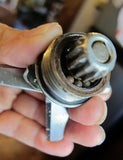
 into the blade assembly housing and will wash out grease. You will see rust powder coming out on the bottom end of the blade assembly at the gear seal. This leads to damage to the bearings which then will not turn smoothly anymore. Bearings are getting hot already when they are in good condition. They become much louder and hotter when there is more friction due to bad bearings. This will lead to oil exit on the bottom outside of the where the gear sticks out of the blender container. When the blade seizes it can also transfer energy to the drive socket and snap it or strip it (Drive socket is on the blender motor).
into the blade assembly housing and will wash out grease. You will see rust powder coming out on the bottom end of the blade assembly at the gear seal. This leads to damage to the bearings which then will not turn smoothly anymore. Bearings are getting hot already when they are in good condition. They become much louder and hotter when there is more friction due to bad bearings. This will lead to oil exit on the bottom outside of the where the gear sticks out of the blender container. When the blade seizes it can also transfer energy to the drive socket and snap it or strip it (Drive socket is on the blender motor).
With the Blendtec blender jars (Wildside, Fourside, Twister), as the picture above left indicates, the 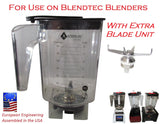 blades are permanent fix installed. If that breaks, you cannot just change the blade assembly, but you have to change the entire jar. There is a big advantage if you have a jar with a removable blade assembly because you just change the blade – see to the right – if you run into a problem. That said, there are in both cases preventative solutions that can help you preserve the blade assembly bearing and help you get more usage out of it
blades are permanent fix installed. If that breaks, you cannot just change the blade assembly, but you have to change the entire jar. There is a big advantage if you have a jar with a removable blade assembly because you just change the blade – see to the right – if you run into a problem. That said, there are in both cases preventative solutions that can help you preserve the blade assembly bearing and help you get more usage out of it
Solution 1: Always wash or rinse the blender jar by hand and then dry by hand to limit water exposure. For additional sanitizing, use a non-caustic water-diluted spray on sanitizing solution to briefly apply to the inside of the jar. Don’t leave jar in sink with water puddle or wash in dishwasher. If your blade has seized up, or shows signs of seizing (roughness of turning, noisier blending, smoke / smell), replace the blade right away to prevent further damage to the driver socket.
Problem 2: Jars, if they do crack, they mostly crack on the very bottom around the hole where the 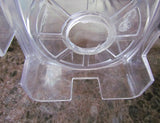 blade assem
blade assem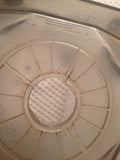 bly inserted into the jar. This occurs mostly when the blade assembly is starting to seize up or has already seized and you keep blending with it and in addition the bottom plate may not be completely tight, or tight enough.
bly inserted into the jar. This occurs mostly when the blade assembly is starting to seize up or has already seized and you keep blending with it and in addition the bottom plate may not be completely tight, or tight enough.
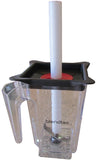 Solution 2: Make sure the blade assembly works well and there is no rust around the gear. If there is and/or you experience leakage on the bottom, immediately remove the blade assembly and inspect the jar and the blade. Replace the blade if the jar is still good. Or else replace the whole jar with blade. We do have new better working blending jars with sharp efficient advanced blending knives. Frequently check the bottom plate to see if you can manage turning it clockwise to tighten it, to make sure it stays tightened.
Solution 2: Make sure the blade assembly works well and there is no rust around the gear. If there is and/or you experience leakage on the bottom, immediately remove the blade assembly and inspect the jar and the blade. Replace the blade if the jar is still good. Or else replace the whole jar with blade. We do have new better working blending jars with sharp efficient advanced blending knives. Frequently check the bottom plate to see if you can manage turning it clockwise to tighten it, to make sure it stays tightened.
 Problem / Solution 3: Simple, if you get stuck or your blender has a hard time getting the ingredients blended or started up, either add more liquid, or if liquid is not part of your recipe, use a tamper stick specifically designed for the use with your blender jar. In our case, we have a Univers
Problem / Solution 3: Simple, if you get stuck or your blender has a hard time getting the ingredients blended or started up, either add more liquid, or if liquid is not part of your recipe, use a tamper stick specifically designed for the use with your blender jar. In our case, we have a Univers al Tamper that can be adjusted to work with any blender jar, from Blendtec to Waring or Hamilton Beach. Make sure you use the tamper to push down on ingredients with the flanges positioned correctly to avoid touching the blades and only inserting the tamper through the lid hole with the cap removed, the lid on the jar, of course.
al Tamper that can be adjusted to work with any blender jar, from Blendtec to Waring or Hamilton Beach. Make sure you use the tamper to push down on ingredients with the flanges positioned correctly to avoid touching the blades and only inserting the tamper through the lid hole with the cap removed, the lid on the jar, of course.
If your Universal tamper accidentally touches the blade knives during blending, this is not a serious problem for the tamper. The material is a food grade FDA approved material, but it is not edible. You will lose your smoothie. But you can save the tamper with sand paper and/or a saw. The Universal Tamper is solid.
If the flang es come apart, use tape to secure the flanges. If you use a wooden tamper it will splinter into oblivion unfortunately and if you use a tamper made with injection molding plastic, it will break and not be usable anymore. If you do not have a tamper, I suggest you get one, even if think you never need one or needed one before. It takes only one time of difficult blending when you lose your hand or your fork. Never insert a fork, knife, or spoon into your blender jar during blending to push down on ingredients.
es come apart, use tape to secure the flanges. If you use a wooden tamper it will splinter into oblivion unfortunately and if you use a tamper made with injection molding plastic, it will break and not be usable anymore. If you do not have a tamper, I suggest you get one, even if think you never need one or needed one before. It takes only one time of difficult blending when you lose your hand or your fork. Never insert a fork, knife, or spoon into your blender jar during blending to push down on ingredients.
Even blenders made to work well without the use of a tamper need a push every now and then. And if you have a blender from a factory that recommends regular usage of a tamper to eliminate their air pocket, you will find,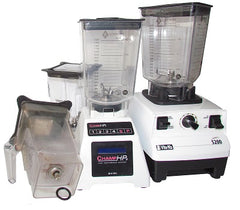 with the right solid – to – liquid ratio, you do not need to use the tamper.
with the right solid – to – liquid ratio, you do not need to use the tamper.
Please check out our new Alterna Jars, sharp blades, advanced finer better smoother blending, interchangeable between Blendtec – Vita Mix – Waring – Omni, etc… blending volume of 80 ounces. Now available with a $10 OFF discount. Use Coupon code $10AlternaOFF (use with purchase $80 and up – good till supply lasts and/or subject to be discontinued without notice)
If you have any questions, feel free to contact us by phone 801-623-3225 or by email customerservice@alternajar.com.
Thomas Fox
www.alternajar.com
801-623-3225
Blenders for the delicious smoothie concoction production are employed in restaurants, smoothie shops, or at home among many people in the world. These blenders come with different features, different sizes of containers, their blades / motors turning in either direction, sharp or dull blades / knives and various different designs of blade knife shapes. The issue discussed here is however the pros and cons of blenders and their jars with a removable or a fixed installed blade assembly.

A removable blade assembly is a blade cutting unit containing the knives connected to a shaft that connects to the blender gear. In between is a bearing that keeps the assembly turning smoothly without interruption. These bearings are a conglomerate of steel, usually carbide steel balls sealed up like also seen and used in roller blades. This sealed bearing unit is inside a housing along the shaft that is sealed from both ends in and outside of the jar to prevent water from leaking through either direction.
The blade assembly is inserted into the jar from the inside, sitting it into a hole on the bottom of the blender container. The blade assembly has a threaded area on the bottom. As inserted, from the outside a so-called nut or blade bottom plate, also known as a blade retaining nut (depending on who is the manufacturer), is then screwed onto the thread. This tightens and seals the blade assembly inside the jar to the container bottom and on the outside bottom. In between the bottom plate and the jar is a O-Ring gasket inserted that prevents water from entering.
Various styles of blades knives exist. Most companies use a 4 part or even a 6 part knife assembly where 4 to 6 knives protrude from the center shaft on top of the blender cutting assembly into different directions. Some of these ends point upwards 45 degrees, some are about horizontal, and others point down.
The blending results vary depending on the blade design together in connection with the layout and design of the blender container subject to specific interaction. The best type of blades are sharpened knives, sharp is better than dull.
These type of blades are usually made for jars that sit on blender motors which turn counter-clockwise. This is really for no scientific particular reason. At least some few smoothie and raw food gurus might claim there could be a cosmic harmony at play if the blender motor and the knife cutting assembly turn with the earth rotation, which is counter-clockwise. This may however at the minimum be really far-fetched from a credible reality.
Blender brands such as Vita-Mix, Waring, Hamilton Beach, JTC Omniblend, Omega, Kitchenaid, along that line, a few among many other blenders, have motors that turn counter-clockwise. In general, and usually, the more expensive upper-blender class has jars with very sturdy durable blade units that are screwed on from the outside of the blender container. The cheaper low-end blenders like Kitchenaid, Oster, Cusineart, and low end Hamilton Beach have much thinner units and also have to come off every time a jar needs washing.
Washing a jar with the blade installed or taken out should always be an option. Taking the blade out may also have the associated benefit to replace if the bearing might be worn out or simply has seized up due to age and wear and tear. It is just more sanitary if a user has the option and discretion to remove the whole blade assembly unit for cleaning, or for replacement if broken, or for sharpening or re-sharpening… any kind of maintenance.
Usually those companies that offer blender jars with removable or replaceable blade assembly cutting units, also offer a jar without blades by itself and the blade assembly by itself.
The bearings of these type of blades are prong usually to seize when over-exposed to water either through washing them in the dishwasher or soaking the jar and the blades inside the sink. It is possible that water could get into the bearing housing, although not likely or it won’t happen easily. It will happen over time due to wear and tear, and then the blade needs to be replaced, one of the advantages a removable blade – type blender container has over a container with a fixed installed blade, because that too tends to seize up.
As far as it is known, only Blendtec® offers a blender jar type with a fixed permanently installed blade. Instead of however equipped with ball bearings, these assemblies consist of bushings. A bushing is as opposed to balls (bearings) depending on a specific design, a buffer, a cushion type of two ends that are greased up and rub against each other in a manner that little friction arises, as little as possible.
In the cases of the Blendtec Jars, either Wildside®, the Fourside®, or the Twister® Jar, Blendtec uses such a bushing instead of ball bearings. This allows for a much smaller housing around the shaft that must stay lubricated to easily turn and follow the torque forced onto the dual wing-tipped blade assembly. By the way, Blendtec blades are not sharp.
The advantage of a bushing is that is uses up less space than the ball bearings in a housing and therefore can be installed closer to the motor gear, of course in respect to other blenders, that being really minimal. The disadvantage is that bushings are usually not as strong and durable as ball bearings.
Water still can get into the though hermetically sealed off blade shaft bushing housing, especially and controversially associated to the lack of usage. Water and usage usually keeps and helps to keep the bushing seal area lubricated and seal. If it dries out too long especially after usage it can often happen that the seal separates and the bushing seizes up and you can’t no longer use the container .
These types of bushing-operated blender blades are not replaceable. Sure they are removable and replaceable if one had the tools to remove them and put them back in once cleaned up and repaired. Consumers, especially however restaurant shop and smoothie shop operators tend to move away from fixed blade blender jars because of the cost factor. They have to replace the whole jar, which is still good and usable, however just because removable blade features are not available.
Other advantages of have a blender jar with the option to remove and replace blades is not just for the purpose of repair and maintenance, but also for opening the door to use and facilitate different styles of blades. Of course a controversy exists that one blade may do it all. But it has been proven, although in general it is true that even a dry blade can blend up wet ingredients, a wet blade also blends very effectively dry grain wheat ingredients and coffee, and ice too can be blended with any of the various blade and knife design setups, that differences and high efficiency outcomes vary subject to blade design. A smoothie shop that makes one kind of an ice type smoothie may over time help to save energy and even prolong the life of the jar and the blades all together as opposed to using a more generic blade assembly unit.
As introduced up on top, blending is done with much variable consideration to the design of the jar, the blades, and the sharpness, as well as the power of the motor, and believe it or not, also of how the ingredients are placed inside a jar, in which order, if hard solid frozen or fresh soft is on top or bottom. Even the use of a tamper adds to the variable of blending effectiveness.
Tampers are mostly only used when the consistency of the ingredients is more solid than liquid – it’s a liquid to solids ratio issue in most cases. As long as the blender unit can turn and create a vortex, the action in which the blades propel all ingredients in a turning action and creating a liquefying emulsifying texture of the ingredients, no tamper is needed. Getting stuck, especially when making intentionally solids purees or paste, even nut butters, some kind of a stir stick, aka plunger (ouch – not toilet related) can just give the push to get that vortex going or to stir the puree into a fine creamy concoction.
Sharper blades can cut better. That is definitely demystified. No way that dull knifes are better than sharp knives. The consumer and commercial smoothie market will soon see the Blendtec blender industry with sharpened knives. As a matter of fact, a company called Alterna jars already has come out with sharpened knives, they are also removable and replaceable, of course. The Alterna jar is made to fit on the Blendtec blenders, as well as with a simple blade assembly switch, will fit also on those blenders that turn counter-clockwise.
 Blenders from Vita-Mix come along with a tamper accelerator tool, whereas Blendtec and Waring do not offer it. Officially advertised, the blending cycles of Blendtec blenders exclude the need for a tamper accelerator tool, and Waring chooses not to avail one to customers. Certain consumers however find it necessary having a tamper present sometimes. Others prepare their smoothie, purees, nut butters, creams, and soups with intent of using a stirring tamper tool.
Blenders from Vita-Mix come along with a tamper accelerator tool, whereas Blendtec and Waring do not offer it. Officially advertised, the blending cycles of Blendtec blenders exclude the need for a tamper accelerator tool, and Waring chooses not to avail one to customers. Certain consumers however find it necessary having a tamper present sometimes. Others prepare their smoothie, purees, nut butters, creams, and soups with intent of using a stirring tamper tool.
While Blendtec is stating as a marketing type method that no tamper is needed, in various cases it is more than handy to have one available because if you do get stuck with your food then it is safer to have one than for example using a fork or spatula to give the ingredients a quick push-down to get the blending motion going.
Different names are assigned to a tamper, relative to its manufacturer, whether from Blendtec, Waring or Vitamix in this case. A majority of individuals refer to it simply as a tamper. This important tool is used for pushing down ingredients to the upper proximity of the blade level, but with some safe distance, to achieve accelerated blending process of content such as raw soup, puree, nut butters, or smoothie. Utilizing an accelerator tool moves ingredients forcefully towards this blade, which rotates at extremely high speeds.
Vita-Mix Accelerator Tool is made from a polycarbonate type plastic comprising a lid hand which closes off the hole formed inside blender container lid while in use. The tool moves freely in and out of the container. Downward action of content creates vacuum action which sucks it into the container as blending takes place. Vita Mix recommends that one use their Accelerator tool throughout the process of blending to expedite the action. Their so-called patented accelerator tools to vacate air pockets are almost needed all the time as per Vita-Mix advertising. But air pockets according to a lawsuit between Vita-Mix and Basic and its follow up appeal confirmed that Vita-Mix however was unable to successfully proof air pockets. One could simply add more water to the ingredients and create the vortex action. But you don’t always want a more liquid concoction.
Certain retro-fitted tamper tools are available in the market. Some blender operators also prefer using a plastic tool or wooden dowel for pushing down towards the blade in rotation to accelerate blending operation. As a result the tamper gets blended up and/or damaged. This could be due to use of an appropriate Accelerator tool with lid in place. If one were not to use a tamper tool appropriately with lid in place, say, for example a fork or knife, or even a hand, pushing down on ingredients that way in high performance blenders could lead to very serious injuries, amputation, and/or damage to the blender units and blades.
Blending Soups and Purees with or without Tamper
When preparing ingredients for smoothies or soups, water is normally added. A tamper may not be necessary to use while blending the content, if sufficient liquid or water is added to the other raw ingredients. A hollow cave area appears just above the blade only when excessive amount of ice is applied for the smoothie process, with the blender cycle turning too fast. Blendtec blenders like the HP3A or Total Blenders are designed with the versatile blending programs it operates, which eliminate the necessity of using a tamper, supposedly. It is “supposedly” because this claim is not always true. There are just too many variables in blending that could be the amount of ingredients, how they are placed, which one first, what consistency they are, what the liquid to solids ratio is, if there are some obstructions like large ice section, and the timing of the blender, the blender motor strength and momentum of turning and starting up, etc. Still, one may require some type of tool to push down the blending ingredients, maybe for stirring, maybe just enough of a push to get the blending action going. Once it is running, meaning you see all the ingredients cycling, the blades will do all the rest of the blending by themselves.
Less amount of liquid is used when preparing a pate or puree in a high-performance blender. One may as well require some form of device for pushing down contents to the blade level. Blendtec especially makes its blenders to operate without needing an accelerator tool or tamper. However, consumers report using cutlery and other equipment to push down the ingredients.
Especially when making nut butters (i.e. Almond butter), a tamper tool is mandatory. The nuts are too heavy and oily, so they are sticky, they just will not freely circulate with the blade turning action. You need to help it to move along and turn over the massive almond puree until it gets oily and is ready for consumption.
The Universal Tamper Accelerator Tool made by Alterna is a great device which fits into any blender jar. Some exceptions exist, like for the Ninja, which lacks the blade construction appropriate for allowing tamper-insertion. The Ninja’s blade is really like an auger that does not let the user insert the tamper. The universality of the Alterna tamper means that it literally can be adjusted and set at different height levels from the area where the tamper is inserted into the jar through the hole in the lid. This adjustability is important to make sure that the tamper will never touch the turning blade during operation when inserted into the jar. Different blender styles and brands have different dimensions from the hole in the lid down to the tip of the blade.
Acetal Delrin, the material employed in making this tamper is approved by FDA “for food contact.” As a precautionary measure, the 2 pieces of flanges (rings) are clamped around the location desired, fitting the tamper in firm manner, the location being the adjustment area that determines the remaining length of the tamper end that is being inserted into the lid cap hole, reaching down towards the blades. This keeps the low tamper-end from touching the blades once inserted through the lid.
The Alterna tamper can fit into Vita-Mix 64 ounce containers, the 32 oz jar, Blendtec Wildside or Fourside, all the Waring and Hamilton Beach blenders, and Kitchenaid, Cusineart, Oster blenders. You name it, if the blender has a jar with a removable lid cap and a regular type blending blade cutting unit, the Universal Tamper come universally adjustable in as a very handy tool. It is apparently better to have it and not need the tamper, than needing it and then using a fork or worse, your hand.
Wood tamper dowels too are becoming quite popular to be used as tampers. They are relatively inexpensive and easy to make when one has a drill machine. Just cut the dowel to length between 8 to 12 inches, usually a dowel with a diameter of 1 inch. Drill in a hole of 3/8” where the appropriate location of the stoppage cross rod should go through to prevent the dowel from entering the jar through the opening in the lid. This cross dowel will prevent the dowel ‘hopefully’ from touching the blades during the blending action. Otherwise, if the wood dowel touches the blades, it will splinter severally making the dowel unusable for future blending actions. Wood also has the likely tendency to absorb water and is therefore very insanitary.
Some people like wood better over plastic, because if by accident one were to blend in untreated wood into ones smoothie, the smoothie would at least still be somewhat edible, subject to one’s appetite. Of course if plastic is blended into a smoothie, you would have to through it all away, for sure. The Acetal Delrin material does not splinter much and therefore unlike with the wood and the completely shattering hollow plastic tamper, Acetal Delrin (POM) is a solid compressed high density material that will be rendered reusable as a tamper stick. From that aspect, and because POM has been used for food processing in food contact for decades, it is an ideal material for the food blending applications as a tamper accelerator tool.


 into the blade assembly housing and will wash out grease. You will see rust powder coming out on the bottom end of the blade assembly at the gear seal. This leads to damage to the bearings which then will not turn smoothly anymore. Bearings are getting hot already when they are in good condition. They become much louder and hotter when there is more friction due to bad bearings. This will lead to oil exit on the bottom outside of the where the gear sticks out of the blender container. When the blade seizes it can also transfer energy to the drive socket and snap it or strip it (Drive socket is on the blender motor).
into the blade assembly housing and will wash out grease. You will see rust powder coming out on the bottom end of the blade assembly at the gear seal. This leads to damage to the bearings which then will not turn smoothly anymore. Bearings are getting hot already when they are in good condition. They become much louder and hotter when there is more friction due to bad bearings. This will lead to oil exit on the bottom outside of the where the gear sticks out of the blender container. When the blade seizes it can also transfer energy to the drive socket and snap it or strip it (Drive socket is on the blender motor). blades are permanent fix installed. If that breaks, you cannot just change the blade assembly, but you have to change the entire jar. There is a big advantage if you have a jar with a removable blade assembly because you just change the blade – see to the right – if you run into a problem. That said, there are in both cases preventative solutions that can help you preserve the blade assembly bearing and help you get more usage out of it
blades are permanent fix installed. If that breaks, you cannot just change the blade assembly, but you have to change the entire jar. There is a big advantage if you have a jar with a removable blade assembly because you just change the blade – see to the right – if you run into a problem. That said, there are in both cases preventative solutions that can help you preserve the blade assembly bearing and help you get more usage out of it blade assem
blade assem
 Solution 2: Make sure the blade assembly works well and there is no rust around the gear. If there is and/or you experience leakage on the bottom, immediately remove the blade assembly and inspect the jar and the blade. Replace the blade if the jar is still good. Or else replace the whole jar with blade. We do have new better working blending jars with sharp efficient advanced blending knives. Frequently check the bottom plate to see if you can manage turning it clockwise to tighten it, to make sure it stays tightened.
Solution 2: Make sure the blade assembly works well and there is no rust around the gear. If there is and/or you experience leakage on the bottom, immediately remove the blade assembly and inspect the jar and the blade. Replace the blade if the jar is still good. Or else replace the whole jar with blade. We do have new better working blending jars with sharp efficient advanced blending knives. Frequently check the bottom plate to see if you can manage turning it clockwise to tighten it, to make sure it stays tightened. Problem / Solution 3: Simple, if you get stuck or your blender has a hard time getting the ingredients blended or started up, either add more liquid, or if liquid is not part of your recipe, use a tamper stick specifically designed for the use with your blender jar. In our case, we have a Univers
Problem / Solution 3: Simple, if you get stuck or your blender has a hard time getting the ingredients blended or started up, either add more liquid, or if liquid is not part of your recipe, use a tamper stick specifically designed for the use with your blender jar. In our case, we have a Univers al Tamper that can be adjusted to work with any blender jar, from Blendtec to Waring or Hamilton Beach. Make sure you use the tamper to push down on ingredients with the flanges positioned correctly to avoid touching the blades and only inserting the tamper through the lid hole with the cap removed, the lid on the jar, of course.
al Tamper that can be adjusted to work with any blender jar, from Blendtec to Waring or Hamilton Beach. Make sure you use the tamper to push down on ingredients with the flanges positioned correctly to avoid touching the blades and only inserting the tamper through the lid hole with the cap removed, the lid on the jar, of course. es come apart, use tape to secure the flanges. If you use a wooden tamper it will splinter into oblivion unfortunately and if you use a tamper made with injection molding plastic, it will break and not be usable anymore. If you do not have a tamper, I suggest you get one, even if think you never need one or needed one before. It takes only one time of difficult blending when you lose your hand or your fork. Never insert a fork, knife, or spoon into your blender jar during blending to push down on ingredients.
es come apart, use tape to secure the flanges. If you use a wooden tamper it will splinter into oblivion unfortunately and if you use a tamper made with injection molding plastic, it will break and not be usable anymore. If you do not have a tamper, I suggest you get one, even if think you never need one or needed one before. It takes only one time of difficult blending when you lose your hand or your fork. Never insert a fork, knife, or spoon into your blender jar during blending to push down on ingredients. with the right solid – to – liquid ratio, you do not need to use the tamper.
with the right solid – to – liquid ratio, you do not need to use the tamper.


